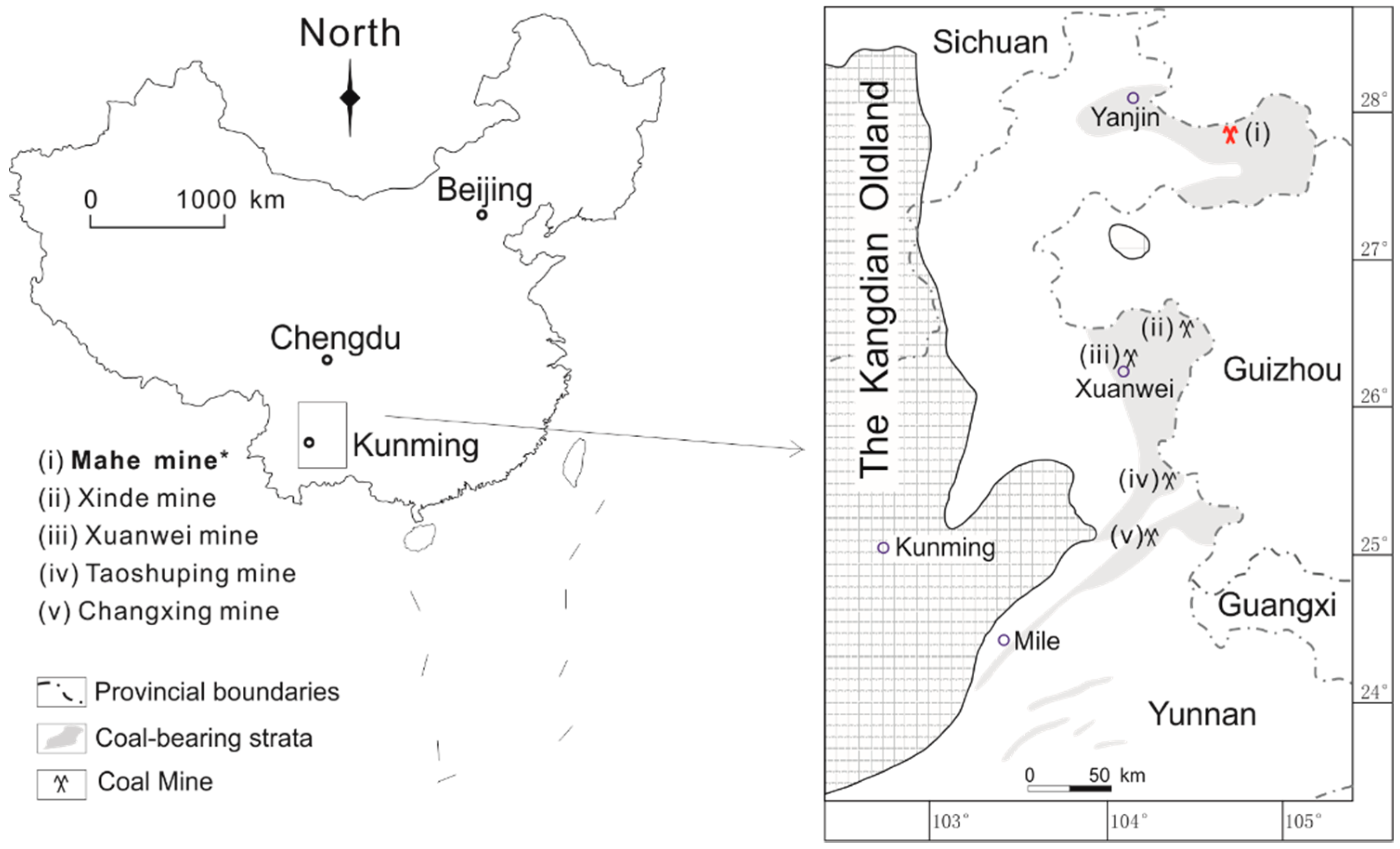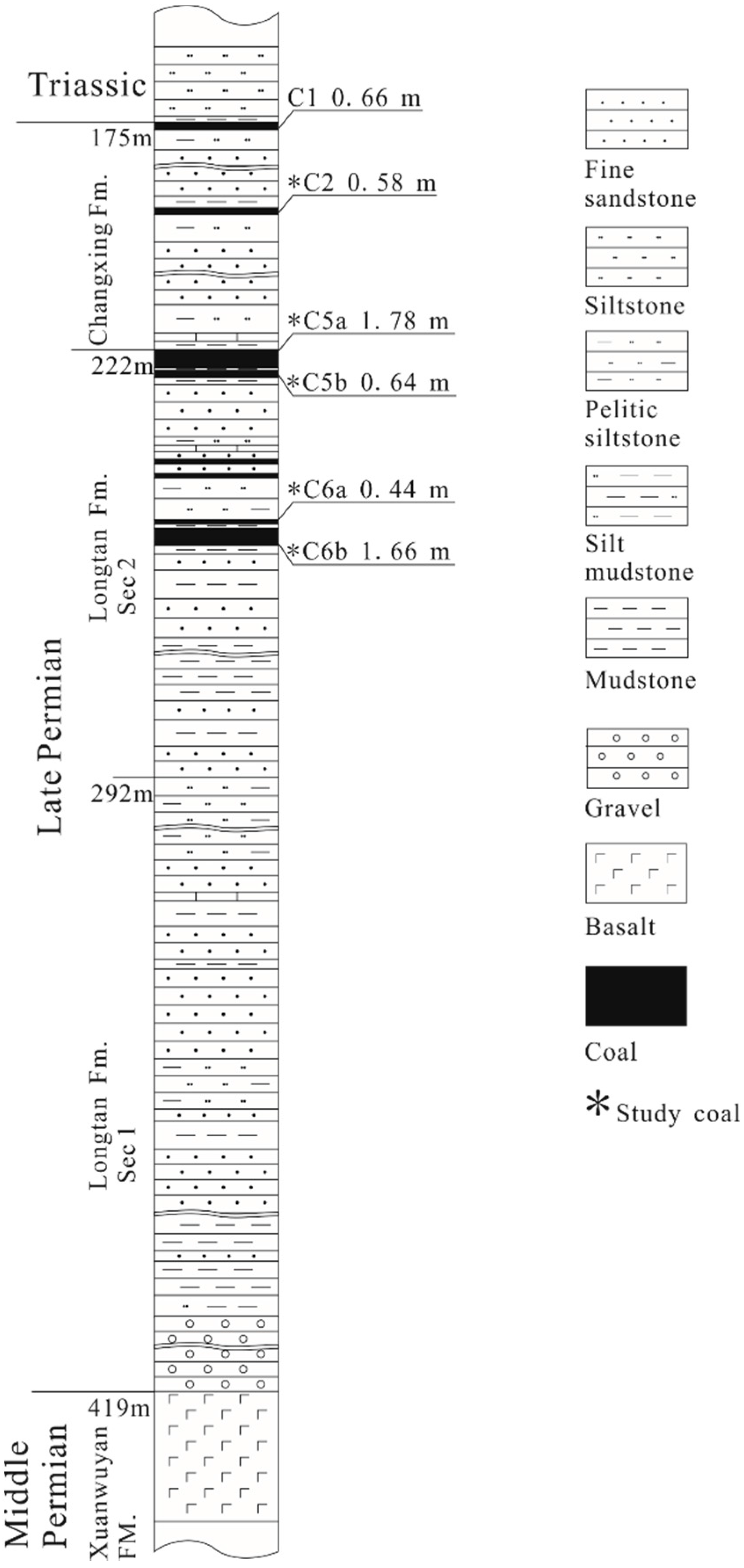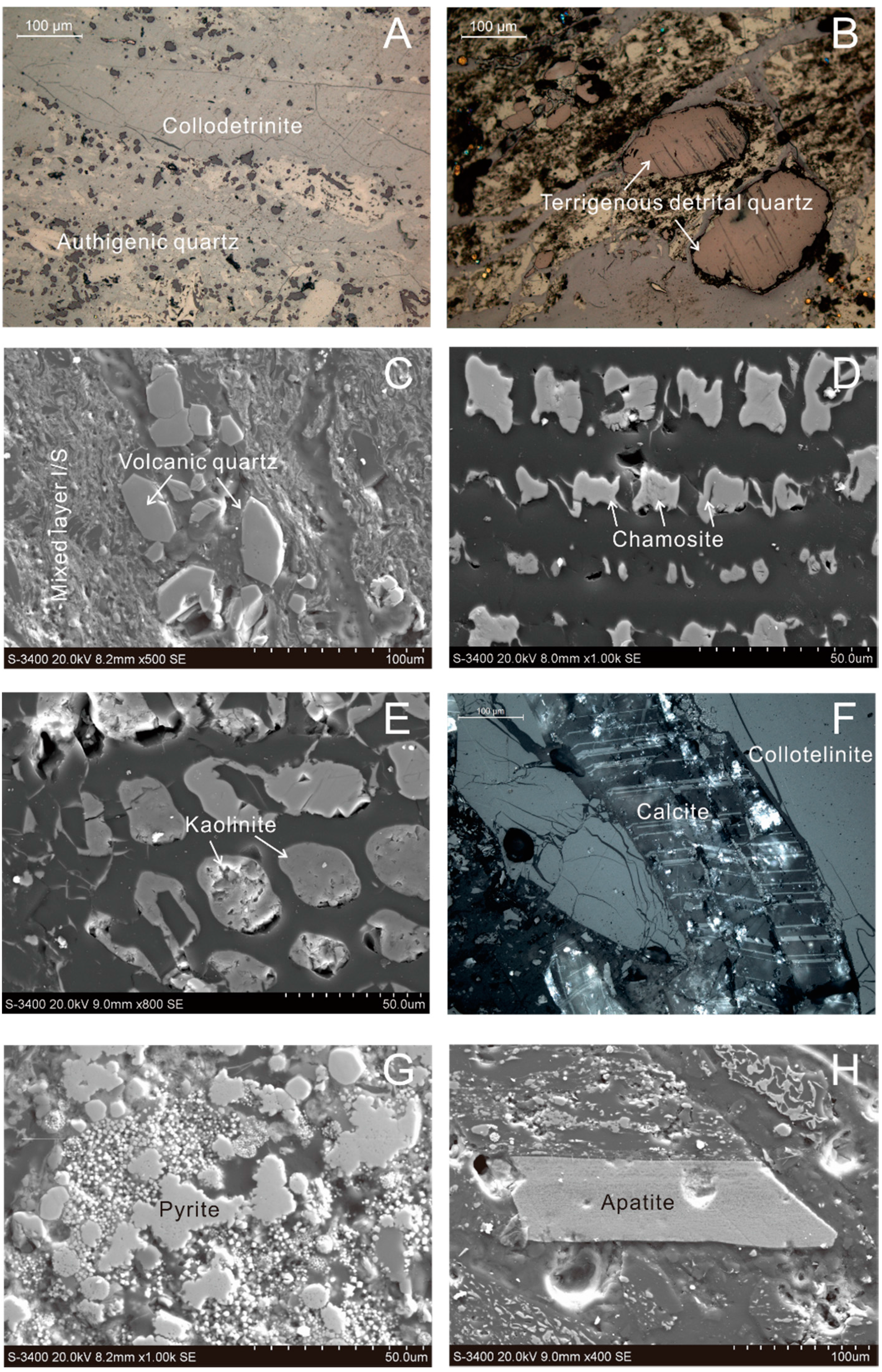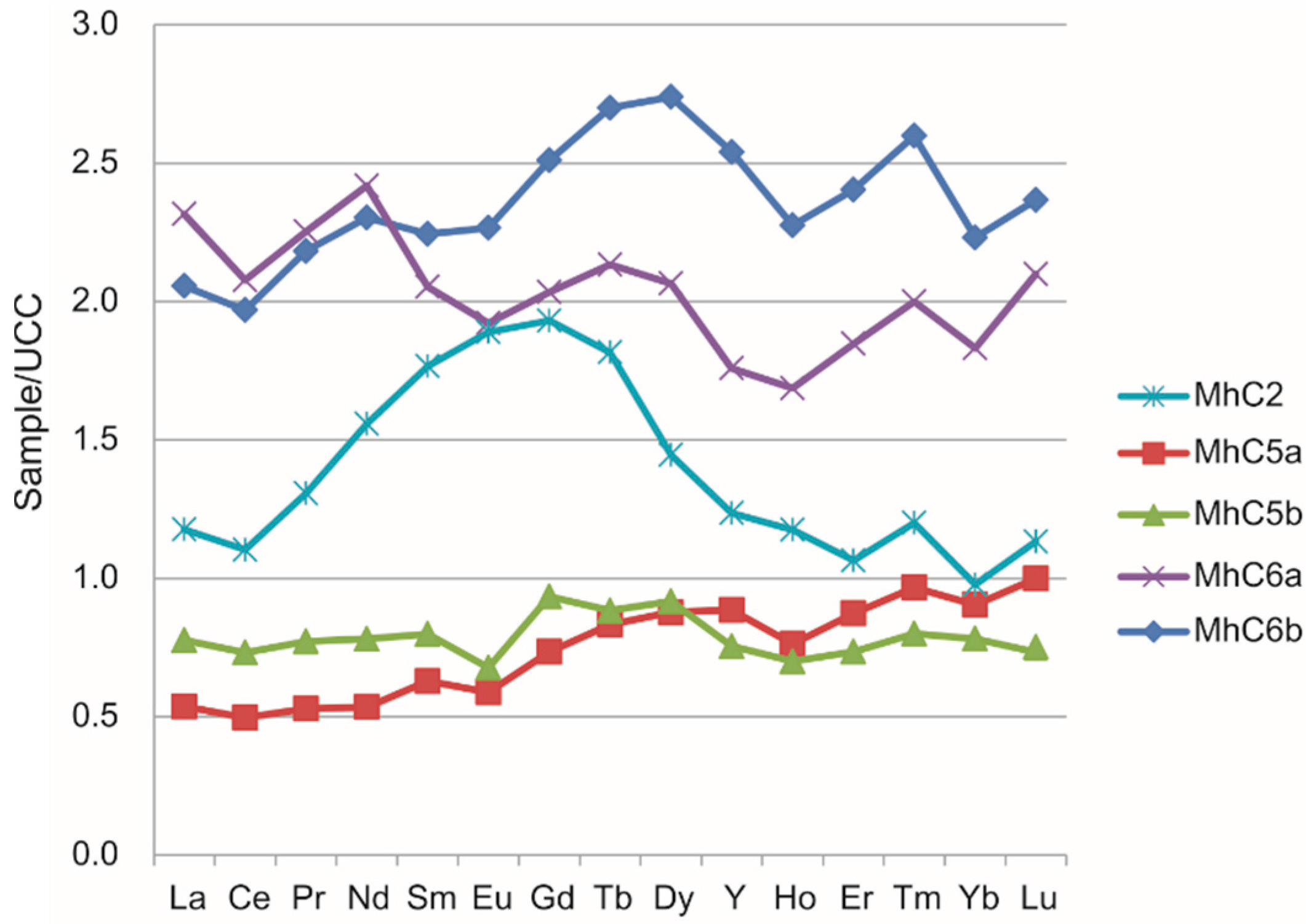Mineralogical and Geochemical Characteristics of Late Permian Coals from the Mahe Mine, Zhaotong Coalfield, Northeastern Yunnan, China
Abstract
:1. Introduction
2. Geological Setting


3. Sample Collection and Methods
| Samples | Mad | Ad | Vdaf | Ro,ran | St,d |
|---|---|---|---|---|---|
| MhC2 | 0.97 | 42.24 | 14.82 | 2.21 | 3.17 |
| MhC5a | 0.7 | 25.75 | 12.86 | 2.27 | 2.31 |
| MhC5b | 0.96 | 33.67 | 13.83 | 2.24 | 3.86 |
| MhC6a | 0.7 | 36.72 | 16.29 | 2.45 | 2.45 |
| MhC6b | 0.66 | 29.62 | 13.67 | 2.31 | 2.49 |
| Average | 0.80 | 33.60 | 14.29 | 2.30 | 2.86 |
| Maximum | 0.97 | 42.24 | 16.29 | 2.45 | 3.86 |
| Minimum | 0.66 | 25.75 | 12.86 | 2.21 | 2.31 |
4. Results
4.1. Coal Chemistry
4.2. Minerals in the Mahe Coals
| Samples | Qu | Ana | Cal | Dol | Sid | Py | Mar | Kao | Cha | Illite | I/S |
|---|---|---|---|---|---|---|---|---|---|---|---|
| Mh C2 | 43.4 | - | 21 | - | 1.2 | 8.2 | - | - | 14.4 | 6.8 | 5 |
| Mh C5a | 49.2 | - | 8 | 1.3 | - | - | - | 26.6 | 12.9 | - | 2.1 |
| Mh C5b | 50.4 | 4.9 | 11.1 | - | - | 10.2 | - | 13.6 | 2.3 | - | 7.5 |
| Mh C6a | 8.9 | 4.5 | 5.1 | 6.1 | 0.6 | 5.5 | 3.4 | 54 | 8.6 | - | 3.3 |
| Mh C6b | 27.8 | - | 4.9 | - | 1 | 10 | 3.3 | 36.6 | 13.8 | - | 2.7 |


4.3. Major and Trace Elements
4.3.1. Major Elements
4.3.2. Trace Elements
| Samples | SiO2 | Al2O3 | CaO | Fe2O3 | K2O | MgO | MnO | Na2O | P2O5 | TiO2 | Li | Be | F | Sc | V | Cr | Co | Ni |
|---|---|---|---|---|---|---|---|---|---|---|---|---|---|---|---|---|---|---|
| MhC2 | 22.92 | 5.11 | 3.14 | 5.37 | 0.68 | 0.48 | 0.07 | 0.08 | 0.17 | 0.23 | 17.5 | 1.36 | 246 | 5.54 | 115 | 31.5 | 14.1 | 29.1 |
| MhC5a | 13 | 5.66 | 2.24 | 2.3 | 0.11 | 0.14 | 0.03 | 0.07 | 0.06 | 0.17 | 26.8 | 1 | 79 | 2.9 | 20.8 | 18 | 12 | 15.9 |
| MhC5b | 18.3 | 7.6 | 1.15 | 3.88 | 0.33 | 0.15 | 0.02 | 0.2 | 0.02 | 0.76 | 23 | 0.93 | 77 | 9.76 | 67.5 | 55 | 22.3 | 20.4 |
| MhC6a | 17.56 | 13.53 | 0.73 | 2.4 | 0.29 | 0.15 | 0.02 | 0.21 | 0.05 | 0.84 | 45.2 | 2.66 | 104 | 13.3 | 182 | 68.4 | 17.5 | 37 |
| MhC6b | 14.78 | 9.39 | 0.61 | 3.04 | 0.19 | 0.15 | 0.01 | 0.16 | 0.04 | 0.5 | 30 | 2.01 | 68 | 13.3 | 139 | 55.4 | 28.9 | 46.5 |
| Averagea | 17.31 | 8.26 | 1.57 | 3.40 | 0.32 | 0.21 | 0.03 | 0.14 | 0.07 | 0.50 | 28.50 | 1.59 | 115 | 8.96 | 105 | 45.66 | 18.96 | 29.78 |
| Coalb | 8.47 | 5.98 | 1.23 | 4.85 | 0.19 | 0.22 | 0.02 | 0.16 | 0.09 | 0.33 | 31.8 | 2.11 | 130 | 4.38 | 35.1 | 15.4 | 7.08 | 13.7 |
| CCc | 2.04 | 1.38 | 1.28 | 0.70 | 1.68 | 0.97 | 1.50 | 0.90 | 0.76 | 1.52 | 0.90 | 0.75 | 0.88 | 2.05 | 2.99 | 2.96 | 2.68 | 2.17 |
| Samples | Cu | Zn | Ga | Ge | Rb | Sr | Y | Zr | Nb | Mo | Sn | Sb | Cs | Ba | La | Ce | Pr | Nd |
| MhC2 | 80.1 | 58.9 | 13.1 | 2.04 | 30.7 | 132 | 27.2 | 77.6 | 6.12 | 2.95 | 3.43 | 0.37 | 1.95 | 87.2 | 35.3 | 70.6 | 9.28 | 40.5 |
| MhC5a | 18.2 | 11.8 | 5.72 | 0.9 | 3.98 | 112 | 19.5 | 53.5 | 4.18 | 0.68 | 3.77 | 0.41 | 0.4 | 30 | 16.1 | 31.8 | 3.76 | 13.9 |
| MhC5b | 45.5 | 32.2 | 10.4 | 1.17 | 15 | 94 | 16.6 | 120 | 16.4 | 1.13 | 4.55 | 0.31 | 0.66 | 98.8 | 23.3 | 46.8 | 5.48 | 20.3 |
| MhC6a | 124 | 40 | 24.3 | 3.44 | 12.7 | 87.8 | 38.7 | 191 | 21.9 | 1.36 | 7.1 | 0.82 | 1.45 | 51.7 | 69.5 | 133 | 16 | 62.9 |
| MhC6b | 84.2 | 36.8 | 21 | 3.45 | 8.52 | 73.5 | 55.9 | 118 | 13.4 | 2.1 | 4.88 | 0.91 | 0.85 | 54.9 | 61.7 | 126 | 15.5 | 59.9 |
| Averagea | 70.40 | 35.94 | 14.90 | 2.20 | 14.18 | 99.86 | 31.58 | 112 | 12.40 | 1.64 | 4.75 | 0.56 | 1.06 | 64.52 | 41.18 | 81.64 | 10.00 | 39.50 |
| Coalb | 17.5 | 41.4 | 6.55 | 2.78 | 9.25 | 140 | 18.2 | 89.5 | 9.44 | 3.08 | 2.11 | 0.84 | 1.13 | 159 | 22.5 | 46.7 | 6.42 | 22.3 |
| CCc | 4.02 | 0.87 | 2.28 | 0.79 | 1.53 | 0.71 | 1.74 | 1.25 | 1.31 | 0.53 | 2.25 | 0.67 | 0.94 | 0.41 | 1.83 | 1.75 | 1.56 | 1.77 |
| Samples | Sm | Eu | Gd | Tb | Dy | Ho | Er | Tm | Yb | Lu | Hf | Ta | Hgd | Tl | Pb | Bi | Th | U |
| MhC2 | 7.95 | 1.7 | 7.34 | 1.09 | 5.06 | 0.94 | 2.45 | 0.36 | 2.15 | 0.34 | 3.44 | 0.44 | 258 | 0.9 | 9.76 | 0.17 | 4.72 | 3.28 |
| MhC5a | 2.83 | 0.53 | 2.79 | 0.5 | 3.07 | 0.61 | 2.01 | 0.29 | 1.99 | 0.3 | 2.49 | 0.33 | 254 | 0.11 | 7.55 | 0.21 | 5.2 | 1.49 |
| MhC5b | 3.59 | 0.61 | 3.55 | 0.53 | 3.21 | 0.56 | 1.69 | 0.24 | 1.72 | 0.22 | 5.11 | 1.14 | 320 | 0.17 | 11.4 | 0.18 | 6.56 | 1.37 |
| MhC6a | 9.24 | 1.73 | 7.73 | 1.28 | 7.23 | 1.35 | 4.25 | 0.6 | 4.03 | 0.63 | 8.99 | 1.57 | 264 | 0.17 | 20.4 | 0.34 | 11.1 | 2.84 |
| MhC6b | 10.1 | 2.04 | 9.54 | 1.62 | 9.59 | 1.82 | 5.53 | 0.78 | 4.91 | 0.71 | 5.46 | 0.97 | 289 | 0.21 | 34.7 | 0.28 | 7.73 | 2.1 |
| Averagea | 6.74 | 1.32 | 6.19 | 1.00 | 5.63 | 1.06 | 3.19 | 0.45 | 2.96 | 0.44 | 5.10 | 0.89 | 277 | 0.31 | 16.76 | 0.24 | 7.06 | 2.22 |
| Coalb | 4.07 | 0.84 | 4.65 | 0.62 | 3.74 | 0.96 | 1.79 | 0.64 | 2.08 | 0.38 | 3.71 | 0.62 | 163 | 0.47 | 15.1 | 0.79 | 5.84 | 2.43 |
| CCc | 1.66 | 1.57 | 1.33 | 1.62 | 1.51 | 1.10 | 1.78 | 0.71 | 1.42 | 1.16 | 1.37 | 1.44 | 1.70 | 0.66 | 1.11 | 0.30 | 1.21 | 0.91 |
4.3.3. Rare Earth Elements and Yttrium (REY)

| Samples | REY (μg/g) | LaN/LuN | LaN/SmN | GdN/LuN | Ce/Ce* | Eu/Eu* |
|---|---|---|---|---|---|---|
| MhC2 | 212 | 1.04 | 0.67 | 1.70 | 0.89 | 1.02 |
| MhC5a | 100 | 0.54 | 0.85 | 0.73 | 0.93 | 0.86 |
| MhC5b | 128 | 1.06 | 0.97 | 1.27 | 0.94 | 0.78 |
| MhC6a | 358 | 1.10 | 1.13 | 0.97 | 0.91 | 0.94 |
| MhC6b | 366 | 0.87 | 0.92 | 1.06 | 0.93 | 0.95 |
5. Discussion: The Sources of Minerals in the Mahe Coals
| Eu/Eu* | Mahe | Xinde* | Xuanwei* | Taoshuping* | Silicic Rock* | Basalt* |
|---|---|---|---|---|---|---|
| Range | 0.78–1.92 | 0.80–1.19 | 0.73–1.27 | 0.77–1.25 | - | - |
| Average | 0.91 | 1.04 | 0.99 | 1.06 | 0.56 | 1.41 |
| Number * | 5 | 9 | 6 | 17 | - | - |
6. Conclusions
Acknowledgments
Author Contributions
Conflicts of Interest
References
- Tian, L. Coal Combustion Emissions and Lung Cancer in Xuan Wei, China. Ph.D. Thesis, University of California, Berkeley, CA, USA, 2005. [Google Scholar]
- Tian, L.; Dai, S.; Wang, J.; Huang, Y.; Ho, S.C.; Zhou, Y.; Lucas, D.; Koshland, C.P. Nanoquartz in Late Permian C1 coal and the high incidence of female lung cancer in the Pearl River Origin area: A retrospective cohort study. BMC Public Health 2008, 8, 398. [Google Scholar] [CrossRef] [PubMed]
- Dai, S.F.; Tian, L.W.; Chou, C.L.; Zhou, Y.P.; Zhang, M.Q.; Zhao, L.; Wang, J.M; Yang, Z.; Cao, H.Z.; Ren, D.Y. Mineralogical and compositional characteristics of Late Permian coals from an area of high lung cancer rate in Xuan Wei, Yunnan, China: Occurrence and origin of quartz and chamosite. Int. J. Coal Geol. 2008, 76, 318–327. [Google Scholar] [CrossRef]
- Dai, S.F.; Li, T.; Seredin, V.V.; Ward, R.C.; Hower, J.C.; Zhou, Y,P.; Zhang, M.Q.; Song, X.L.; Song, W.J.; Zhao, C.L. Origin of minerals and elements in the Late Permian coals, tonsteins, and host rocks of the Xinde Mine, Xuanwei, eastern Yunnan, China. Int. J. Coal Geol. 2014, 121, 53–78. [Google Scholar] [CrossRef]
- Large, D.J.; Kelly, S.; Spiro, B.; Tian, L.; Shao, L.; Finkelman, R.; Zhang, M.; Somerfield, C.; Plint, S.; Ali, Y.; et al. Silica-volatile interaction and the geological cause of the Xuan Wei lung cancer epidemic. Environ. Sci. Technol. 2009, 43, 9016–9021. [Google Scholar] [CrossRef] [PubMed]
- Wang, X.; Dai, S.; Chou, C.-L.; Zhang, M.; Wang, J.; Song, X.; Wang, W.; Jiang, Y.; Zhou, Y.; Ren, D. Mineralogy and geochemistry of Late Permian coals from the Taoshuping Mine, Yunnan Province, China: Evidences for the sources of minerals. Int. J. Coal Geol. 2012, 96–97, 49–59. [Google Scholar] [CrossRef]
- Dai, S.; Wang, X.; Zhou, Y.; Hower, J.C.; Li, D.; Chen, W.M.; Zhu, X.W. Chemical and mineralogical compositions of silicic, mafic, and alkali tonsteins in the late Permian coals from the Songzao Coalfield, Chongqing. Southwest China. Chem. Geol. 2011, 282, 29–44. [Google Scholar] [CrossRef]
- Zhou, Y.; Bohor, B.F.; Ren, Y.L. Trace element geochemistry of altered volcanic ash layers (tonsteins) in Late Permian coal-bearing formations of eastern Yunnan and western Guizhou Province, China. Int. J. Coal Geol. 2000, 44, 305–324. [Google Scholar] [CrossRef]
- Dai, S.F.; Chou, C.L. Occurrence and origin of minerals in a chamosite-bearing coal of Late Permian age, Zhaotong, Yunnan, China. Am. Mineral. 2007, 92, 1253–1261. [Google Scholar] [CrossRef]
- Coal Geology Bureau of China. Sedimentary Environments and Coal Accumulation of Late Permian Coal Formation in Western Guizhou., Southern Sichuan and Eastern Yunnan, China; Chongqing University Press: Chongqing, China, 1996. (In Chinese) [Google Scholar]
- He, B.; Xu, Y.G.; Huang, X.L.; Luo, Z.Y.; Shi, Y.R.; Yang, Q.J.; Yu, S.Y. Age and duration of the Emeishan Flood volcanism, SW China: Geochemistry and SHRIMP zircon U-Pb dating of silicic ignimbrites, post volcanic Xuanwei Formation and clay tuff at Chaotian section. Earth Planet. Sci. Lett. 2007, 255, 306–323. [Google Scholar] [CrossRef]
- He, B.; Xu, Y.G.; Guan, J.P.; Zhong, Y.T. Paleokarst on the top of the Maokou Formation: Further evidence for domal crustal uplift prior to the Emeishan flood volcanism. Lithos 2010, 119, 1–9. [Google Scholar] [CrossRef]
- ASTM International. Test Method for Moisture in the Analysis Sample of Coal and Coke; ASTM D3173-11; ASTM International: West Conshohocken, PA, USA, 2011. [Google Scholar]
- ASTM International. Test Method for Volatile Matter in the Analysis Sample of Coal and Coke; ASTM D3175-11; ASTM International: West Conshohocken, PA, USA, 2011. [Google Scholar]
- ASTM International. Test Method for Ash in the Analysis Sample of Coal and Coke from Coal; ASTM D3174-11; ASTM International: West Conshohocken, PA, USA, 2011. [Google Scholar]
- ASTM International. Test Methods for Total Sulfur in the Analysis Sample of Coal and Coke; ASTM D3177-02; ASTM International: West Conshohocken, PA, USA, 2011. [Google Scholar]
- Ward, C.R.; Spears, D.A.; Booth, C.A.; Staton, I.; Gurba, L.W. Mineral matter and trace elements in coals of the Gunnedah Basin, NewSouth Wales, Australia. Int. J. Coal Geol. 1999, 40, 281–308. [Google Scholar] [CrossRef]
- Ward, C.R.; Matulis, C.E.; Taylor, J.C.; Dale, L.S. Quantification of mineral matter in the Argonne Premium coals using interactive Rietveld-based X-ray diffraction. Int. J. Coal Geol. 2001, 46, 67–82. [Google Scholar] [CrossRef]
- Ruan, C.-D.; Ward, C.R. Quantitative X-ray powder diffraction analysis of clay minerals in Australian coals using Rietveld methods. Appl. Clay Sci. 2002, 21, 227–240. [Google Scholar] [CrossRef]
- Dai, S.F.; Li, T.J.; Jiang, Y.F.; Ward, C.R.; Hower, J.C.; Sun, J.H.; Liu, J.J.; Song, H.J.; Wei, J.P.; Li, Q.Q.; et al. Mineralogical and geochemical compositions of the Pennsylvanian coal in the Hailiushu Mine, Daqingshan Coalfield, Inner Mongolia, China: Implications of sediment-source region and acid hydrothermal solutions. Int. J. Coal Geol. 2015, 137, 92–110. [Google Scholar] [CrossRef]
- Dai, S.F.; Hower, J.C.; Ward, C.R.; Guo, W.M.; Song, H.J.; O’Keefe, J.M.K.; Xie, P.P.; Hood, M.M.; Yan, X.Y. Elements and phosphorus minerals in the middle Jurassic inertinite-rich coals of the Muli Coalfield on the Tibetan Plateau. Int. J. Coal Geol. 2015, 144–145, 23–47. [Google Scholar] [CrossRef]
- ASTM International. Standard Test Method for Total Fluorine in Coal and Coke by Pyrohydrolytic Extraction and Ion Selective Electrode or Ion Chromatograph Methods; ASTM Standard D5987-96 (2002) (Reapproved 2007); ASTM International: West Conshohocken, PA, USA, 2011. [Google Scholar]
- ASTM International. Standard Classification of Coals by Rank; ASTM D388-12; ASTM International: West Conshohocken, PA, USA, 2012. [Google Scholar]
- Standardization Administration of the People’s Republic of China. Classification for Quality of Coal. Part 1: Ash, 2010; Chinese Standard GB/T 15224, 1-2010; Standardization Administration of the People’s Republic of China: Beijing, China. (In Chinese)
- Standardization Administration of the People’s Republic of China. Classification for Quality of Coal. Part 2: Sulfur, 2010; Chinese Standard GB/T 15224, 2–2010; Standardization Administration of the People’s Republic of China: Beijing, China. (In Chinese)
- Wang, X.; Zhang, M.; Zhang, W.; Wang, J.; Zhou, Y.; Song, X.; Li, T.; Li, X.; Liu, H.; Zhao, L. Occurrence and origins of minerals in mixed-layer illite/smectite-rich coals of the Late Permian age from the Changxing Mine, eastern Yunnan, China. Int. J. Coal Geol. 2012, 102, 26–34. [Google Scholar] [CrossRef]
- Tang, X.Y.; Huang, W.H. Trace Elements in Chinese Coal; Business Press: Beijing, China, 2004. (In Chinese) [Google Scholar]
- Faraj, B.S.M.; Fielding, C.R.; Mackinnon, D.R. Cleat mineralization of Upper Permian Baralaba/Rangal Coal Measures, Bowen Basin, Australia. In Coalbed Methane and Coal Geology; Gayer, R., Harris, I., Eds.; Geological Society Special Publication: London, UK, 1996; Volume 109, pp. 151–164. [Google Scholar]
- Permana, A.; Ward, C.R.; Li, Z.; Gurba, L.W. Distribution and origin of minerals in high-rank coals of the South Walker Creek area, Bowen Basin, Australia. Int. J. Coal Geol. 2013, 116–167, 185–207. [Google Scholar] [CrossRef]
- Vassilev, S.V.; Kitano, K.; Vassileva, C.G. Some relationships between coal rank and chemical and mineral composition. Fuel 1996, 75, 1537–1542. [Google Scholar] [CrossRef]
- Wang, X.B.; Jiang, Y.F.; Zhou, G.Q.; Wang, P.P.; Wang, R.X.; Zhao, L.; Chou, C.-L. Behavior of minerals and trace elements during natural coking: A case study of an intruded bituminous coal in the Shuoli mine, Anhui Province, China. Energy Fuels 2015. [Google Scholar] [CrossRef]
- Ward, C.R. Analysis and significance of mineral matter in coal seams. Int. J. Coal Geol. 2002, 50, 135–168. [Google Scholar] [CrossRef]
- Dai, S.F.; Seredin, V.V.; Ward, C.R.; Hower, J.C.; Xing, Y.W.; Zhang, W.G.; Song, W.J.; Wang, P.P. Enrichment of U–Se–Mo–Re–V in coals preserved within marine carbonate successions: Geochemical and mineralogical data from the Late Permian Guiding Coalfield, Guizhou, China. Miner. Deposita 2015, 50, 159–186. [Google Scholar] [CrossRef]
- Bouška, V.; Pešek, J.; Sýkorová, I. Probable modes of occurrence of chemical elements in coal. Acta Mont. Ser. B Fuel Carbon Miner. Process. 2000, 10, 53–90. [Google Scholar]
- Dai, S.F.; Yang, J.Y.; Ward, C.R.; Hower, J.C.; Liu, H.D.; Garrison, T.M.; French, D.; O’Keefe, J.M.K. Geochemical and mineralogical evidence for a coal-hosted uranium deposit in the Yili Basin, Xinjiang, northwestern China. Ore Geol. Rev. 2015, 70, 1–30. [Google Scholar] [CrossRef]
- Chou, C.-L. Sulfur in coals: A review of geochemistry and origins. Int. J. Coal Geol. 2012, 100, 1–13. [Google Scholar] [CrossRef]
- Dai, S.F.; Ren, D.Y.; Chou, C.L.; Finkelman, R.B.; Seredin, V.V.; Zhou, Y.P. Geochemistry of trace elements in Chinese coals: A review of abundances, genetic types, impacts on human health, and industrial utilization. Int. J. Coal Geol. 2012, 94, 3–21. [Google Scholar] [CrossRef]
- Xiao, L.; Xu, Y.; Mei, H.; Zheng, Y.; He, B.; Pirajno, F. Distinct mantle sources of low-Ti and high-Ti basalts from the western Emeishan large igneous province, SW China: Implications for plume-lithosphere interaction. Earth Planet. Sci. Lett. 2004, 228, 525–546. [Google Scholar] [CrossRef]
- Dai, S.F; Zeng, R.S; Sun, Y.Z. Enrichment of arsenic, antimony, mercury, and thallium in a late Permian anthracite from Xingren, Guizhou, southwest China. Int. J. Coal Geol. 2006, 66, 217–226. [Google Scholar] [CrossRef]
- Hower, J.C.; Campbell, J.L.; Teesdale, W.J.; Nejedly, Z.; Robertson, J.D. Scanning proton microprobe analysis of mercury and other trace elements in Fe-sulfides from a Kentucky coal. Int. J. Coal Geol. 2008, 75, 88–92. [Google Scholar] [CrossRef]
- Yudovich, Ya.E.; Ketris, M.P. Mercury in coal: A review. Part 1. Geochemistry. Int. J. Coal Geol. 2005, 62, 107–134. [Google Scholar] [CrossRef]
- Seredin, V.V.; Dai, S. Coal deposits as a potential alternative source for lanthanides and yttrium. Int. J. Coal Geol. 2012, 94, 67–93. [Google Scholar] [CrossRef]
- Taylor, S.R.; McLennan, S.M. The Continental Crust: Its Composition and Evolution; Blackwell: Oxford, UK, 1985; p. 312. [Google Scholar]
- Seredin, V.; Finkelman, R. Metalliferous coals: A review of the main genetic and geochemical types. Int. J. Coal Geol. 2008, 76, 253–289. [Google Scholar] [CrossRef]
- Ren, D.Y. Mineral matter in coal. In Coal Petrology of China; Han, D.X., Ed.; Publishing House of China University of Mining and Technology: Xuzhou, China, 1996; pp. 67–78. [Google Scholar]
- Kolker, A.; Chou, C.-L. Cleat-filling calcite in Illinois Basin coals: Trace element evidence for meteoric fluid migration in a coal basin. J. Geol. 1994, 102, 111–116. [Google Scholar] [CrossRef]
- Xu, Y.G.; Chung, S.L.; Jahn, B.M.; Wu, G.Y. Petrologic and geochemical constraints on the petrogenesis of Permian-Triassic Emeishan flood basalts in southwestern China. Lithos 2001, 58, 145–168. [Google Scholar] [CrossRef]
- Xu, Y.G.; Chung, S.L.; Shao, H.; He, B. Silicic magmas from the Emeishan large igneous province, southwest China: Petrogenesis and their link with the end-Guadalupian biological crisis. Lithos 2010, 119, 47–60. [Google Scholar] [CrossRef]
- Goodarzi, F.; Sanei, H.; Stasiuk, L.D.; Bagheri-Sadeghi, H.; Reyes, J. A preliminary study of mineralogy and geochemistry of four coal samples from northern Iran. Int. J. Coal Geol. 2006, 65, 35–50. [Google Scholar] [CrossRef]
© 2015 by the authors; licensee MDPI, Basel, Switzerland. This article is an open access article distributed under the terms and conditions of the Creative Commons Attribution license (http://creativecommons.org/licenses/by/4.0/).
Share and Cite
Wang, X.; Wang, R.; Wei, Q.; Wang, P.; Wei, J. Mineralogical and Geochemical Characteristics of Late Permian Coals from the Mahe Mine, Zhaotong Coalfield, Northeastern Yunnan, China. Minerals 2015, 5, 380-396. https://doi.org/10.3390/min5030380
Wang X, Wang R, Wei Q, Wang P, Wei J. Mineralogical and Geochemical Characteristics of Late Permian Coals from the Mahe Mine, Zhaotong Coalfield, Northeastern Yunnan, China. Minerals. 2015; 5(3):380-396. https://doi.org/10.3390/min5030380
Chicago/Turabian StyleWang, Xibo, Ruixue Wang, Qiang Wei, Peipei Wang, and Jianpeng Wei. 2015. "Mineralogical and Geochemical Characteristics of Late Permian Coals from the Mahe Mine, Zhaotong Coalfield, Northeastern Yunnan, China" Minerals 5, no. 3: 380-396. https://doi.org/10.3390/min5030380
APA StyleWang, X., Wang, R., Wei, Q., Wang, P., & Wei, J. (2015). Mineralogical and Geochemical Characteristics of Late Permian Coals from the Mahe Mine, Zhaotong Coalfield, Northeastern Yunnan, China. Minerals, 5(3), 380-396. https://doi.org/10.3390/min5030380






